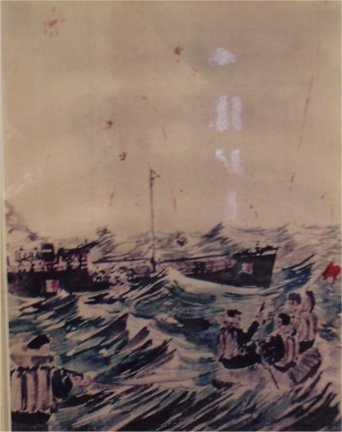Irish Legal Heritage: Rescue and internment of belligerents during WWII

Sketch of the Kerlogue Rescue by Hans Helmut Karsch
During World War II, Ireland’s official policy was one of neutrality. Under international law, the state was required to arrest and intern belligerents who landed here by accident – or in some cases were rescued by Irish ships. A total of 314 belligerent personnel were interned at the Curragh Camp in Kildare – 269 of whom were Axis airmen and sailors, and 45 of whom were Allied aircrew (Bernard Kelly, Military Internees, Prisoners of War and the Irish State during the Second World War (Palgrave Macmillan 2015)).
One of the most famous rescues by an Irish ship during the war was in the aftermath of the Battle of the Bay of Biscay. On the 29th of December 1943, a ship called the Kerlogue was en route back to Ireland with a cargo of oranges when it responded to an SOS signal and altered course to rescue 168 German sailors. Despite pressure from the British and from the Germans to bring the survivors elsewhere, the captain of the Kerlogue brought the men to Cobh, County Cork.
Four of the men died before the boat reached Cobh, and the 164 survivors were brought to the Curragh where they were interned until the end of the war. While at the Curragh, the internees were able to leave the camp and go to nearby towns on parole – on the basis that they would not “make or endeavour to make any arrangements whatever or seek or accept any assistance whatever” to escape, and that they would not “engage in any military activities or any activities contrary to the interests of Eire”.
One of the sailors who was rescued by the Kerlogue was Hans Helmut Karsch, an 18-year-old from Dusseldorf. While he was interned, he sketched scenes of the battle and the rescue mission, some of which have been donated to the National Maritime Museum of Ireland. In the sketch of the Kerlogue you can see the Irish tricolours painted on the sides of the small ship to signal its neutrality.












